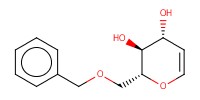
|
Glycan Syntheses |
JCGG ID |
JCGG-RAC0001082 | ||||
Submitter |
The Noguchi Institute | ||||
Reaction ID |
R-0000-001089

|
||||
Regist Date |
2012/06/21 16:38:35 | ||||
| REACTANT | |||||
|
|

|
||||
Reactant Type |
6-benzylglucal | ||||
Mol |
11.1 mmol | ||||
|
|

|
||||
Reactant Type |
DMAP | ||||
Mol |
catalytic amount | ||||
|
|

|
||||
Reactant Type |
pyridine | ||||
Mol |
33.3 mmol | ||||
|
|

|
||||
Reactant Type |
trimethylacetyl chloride | ||||
Mol |
16.6 mmol | ||||
|
|

|
||||
Reactant Type |
Et3N | ||||
Mol |
30.5 mmol | ||||
|
|

|
||||
Reactant Type |
TESOTf | ||||
Mol |
10.7 mmol | ||||
|
|

|
||||
Reactant Type |
DIBAL-H (1 M in PhCH3) | ||||
Volume |
14.6 mL | ||||
|
|

|
||||
Reactant Type |
H2O | ||||
Volume |
10 mL | ||||
| PRODUCT | |||||
MOLECULE ID |
|

|
|||
Yield |
48.38%(72%, 96%, 70%) | ||||
| REACTION DETAIL | |||||
Reaction Time |
24 hours, 2 hours, 1 hour, overnight | ||||
Reaction Temp |
room temp, 0 degree C, -78 degree C, room temp | ||||
Solvent |
CH2Cl2, CH2Cl2, CH2Cl2, CH2Cl2 | ||||
Comment |
1) 61+DMAP, pyridine, trimethylacetyl chloride, 2) +Et3N, TESOTf, 3) +DIBAL, 4) +H2O | ||||
| The reactants were mixed at 0 degree in Celsius before stirred at room temperature. (first phase) | |||||
| COMMENT | |||||
| There are four phases in this reaction. | |||||
| ATTENTION: There are numerical discrepancies between the scheme and the written method. (the number of % yield) | |||||
| REFERENCE | |||||
Reference Id |
REF-0000-000048 | ||||
Issn |
|||||
PubMed ID |
11273599 | ||||
Journal Name |
Journal of the American Chemical Society. (2001) 123 (1): 35-48. | ||||
Article Title |
Total syntheses of tumor-related antigens N3: probing the feasibility limits of the glycal assembly method. | ||||
Author |
H M, Kim; I J, Kim; S J, Danishefsky | ||||
Affiliation |
Laboratory for Bioorganic Chemistry, Sloan-Kettering Institute for Cancer Research, 1275 York Ave., New York, New York 10021, USA. | ||||
Reference Id |
REF-0000-000049 | ||||
Source |
J. Am. Chem. Soc. 2001, 123, 35-48 | ||||
Doi |
10.1021/ja0022730 | ||||
©2008-2013 Research Center for Medical Glycoscience, National Institute of Advanced Industrial Science and Technology (AIST)
|